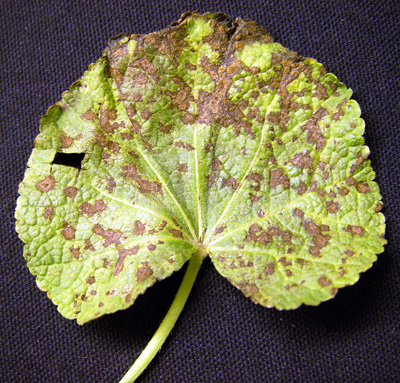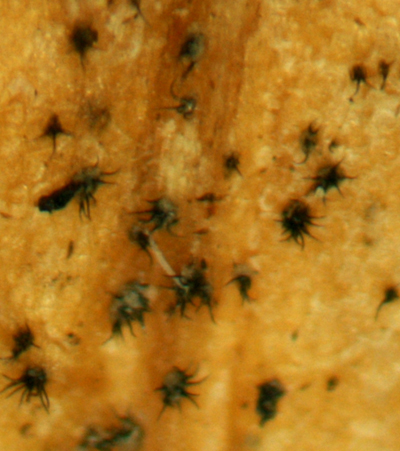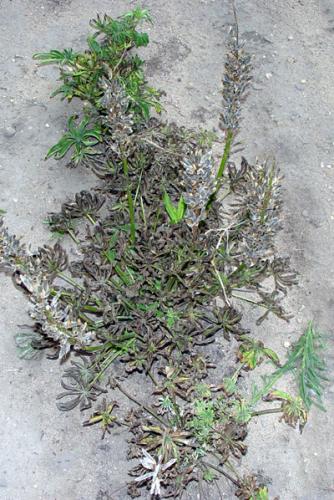Anthracnose
July 6, 2015
Fungal leaf spots
Pathogen
Colletotrichum spp.
Hosts include
Althaea, Bergenia, Heuchera, Hosta, Limonium, Sedum and Lupinus.

Severe leaf spotting on a young hollyhock leaf.
Symptoms
 Symptoms vary, depending on the host. Althaea seedlings and young plants are especially susceptible to infection: leaf spotting and stem lesions can be severe. Lupine seedlings are especially vulnerable: infected plants wilt and have necrotic lesions on stems. Leaf spots, shepherd’s crooks and crown rot develop on more mature lupine plants (see photo). Anthracnose causes severe stem girdling and crown rot on sedum. Susceptibility varies with cultivar. Infection on hosta causes leaf spots with bleached out centers and reproductive structures (black dots) are often visible in these lesions.
Symptoms vary, depending on the host. Althaea seedlings and young plants are especially susceptible to infection: leaf spotting and stem lesions can be severe. Lupine seedlings are especially vulnerable: infected plants wilt and have necrotic lesions on stems. Leaf spots, shepherd’s crooks and crown rot develop on more mature lupine plants (see photo). Anthracnose causes severe stem girdling and crown rot on sedum. Susceptibility varies with cultivar. Infection on hosta causes leaf spots with bleached out centers and reproductive structures (black dots) are often visible in these lesions.

Setae, produced in clumps on the surface of dead plant material, are a diagnostic structure.
Spread
Disease can be seed-borne in some perennial crops. The pathogen persists on infested material. Spores are splash-dispersed by rain and irrigation.
Management
Space plants to promote air circulation around them. Remove diseased plant material – Colletotrichum. spp. will sporulate readily on dead plant material in the production area. Fungicide applications may be needed. Lupine seedlings can be infected by seed- borne inoculum. Disease management must rely heavily on the use of disease-free seed and fungicide applications to seedlings.

Foliar dieback symptoms on a larger, more mature lupine plant.
Print a PDF of this page: Fungal leaf spots



 Print
Print Email
Email




